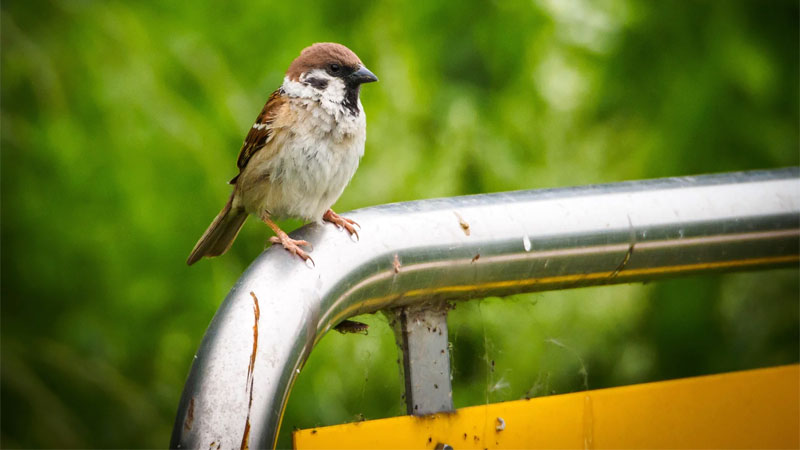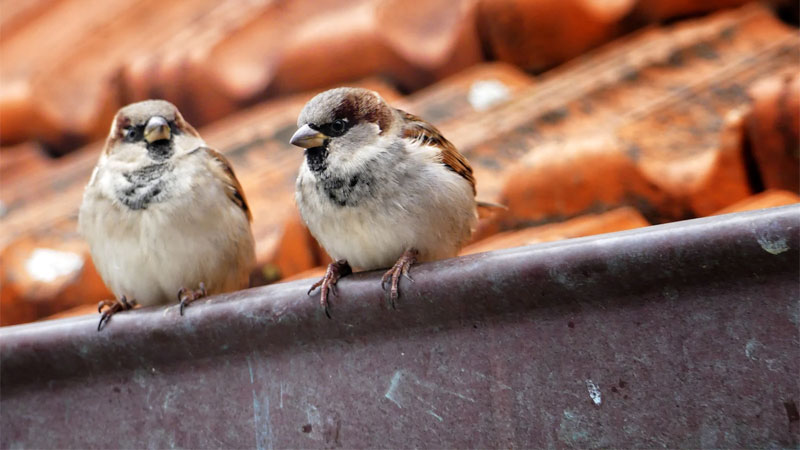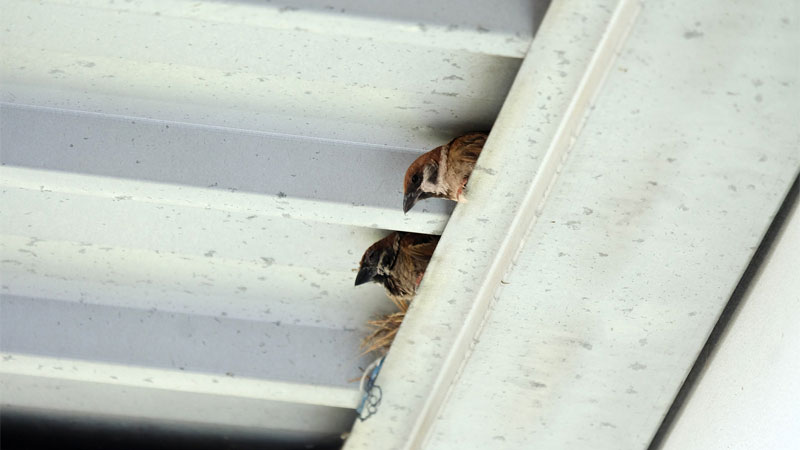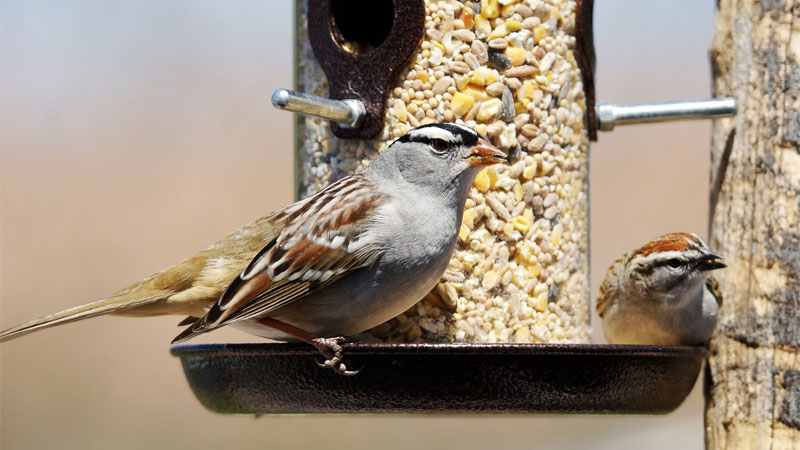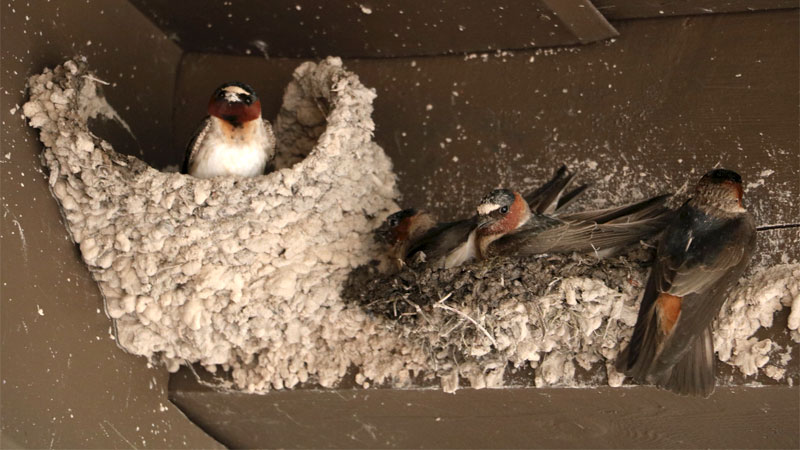When it comes to small birds, few are as well-loved as the sparrow. However, that love isn’t universal and these wonderful little critters can become a nuisance or even a pest. But nearly all of the problems caused by sparrows in the US are blamed on one particular species: the house sparrow (Passer domesticus).
But what is it about this species that makes them so iconic while also being so frustrating to some people? And how do you deal with these wonderful birds when they start doing unwelcome things on your property?
Let’s dive into the field and steal some seeds of wisdom on how to get rid of sparrows around your property.
Getting to Know Sparrows
What you might know of as a sparrow can be a bit deceiving. In fact, sparrows belong to two families in the massive Passeriformes order.
Over half of all the bird species in the world belong to this order and are collectively known as passerines. The name of the order literally means “sparrow-shaped” and all birds of the order have four toes, three of which face forward.
Within this order are 6,500 species across more than 140 families, However, only two of these families are commonly referred to as sparrows.
Passeridae (Old World sparrows) is the family commonly referred to as the “true sparrows” and has 43 different species across eight genera. The second family is Passerellidae, or the New World sparrows, which has 138 species in 30 genera.
However, while these two families look similar, it’s actually one of the 28 members of the Old World genus Passer that we’re concerned about. But wait, doesn’t Old World mean Europe…?
Origin of the House Sparrow
The house sparrow is indeed a European species and may well be one of the species that have been kept as pets as far back as Ancient Egypt. However, a lapse of judgment means this species can now be found in the Americas, Australia, Asia, and Africa, making it one of the most widely distributed species out there
As the scientific name implies, house sparrows are domesticated and actually avoid areas where there are no people. Measuring a little over six inches long and weighing around an ounce, these tiny birds can be quite beneficial.
Farmers in the Old World appreciated the fact that house sparrows were opportunistic insectivores and would hang out near farms, protecting crops while also being pretty to look at. It’s widely believed that this is the reason they were introduced to the Americas and Australia, although their presence in Asia and Africa might have been accidental.
When Sparrows Become a Problem
Unfortunately, farmers weren’t paying close enough attention to the habits of house sparrows when they exported them to the Colonies. In North America, they were part of a mass introduction in 1852 when New York City released several species of European birds to help combat a growing linden moth problem.
Unfortunately, the bird’s ability to cohabitate with humans and their strong immune systems quickly resulted in a population explosion.
Nesting Habits
House sparrows prefer to nest in tight spaces, often leading them to build their nests in the eaves of houses. They can also get competitive with native species. Sometimes they’ll even attack other birds to claim an existing nest in tree hollows or a nest box. This aggression has contributed to the decline of bluebirds and similar nesting birds.
Their Unexpected Favorite Food
But getting back to farmers, house sparrows pose another huge concern. It turns out that the house sparrow isn’t actually an insectivore, but prefers seeds and grains with the occasional insect for variety.
As a result, they can be devastating to grain crops, ravage sunflowers and other seed crops, and will often raid bird feeders in groups that prevent other species from having access.
Health Risks
A final problem that can make house sparrows a pest is the presence of pathogens and parasites. Salmonella is a common problem, and a large percentage of the parasites and diseases a house sparrow can carry are also common among humans and pets.
Bird mites are another problem and they can sometimes make their way into your home. This means that sparrows nesting on your property may pose a health risk depending on how much exposure you have to them.
Sparrow vs Swallow
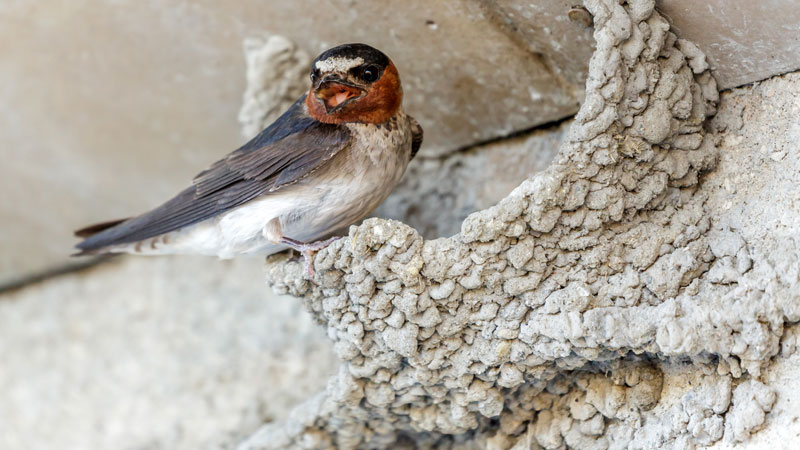
Sparrows can often be mistaken for a wide range of other passerines. Even worse, it would take a small encyclopedia to show the differences between every passerine out there. However, you can get a good idea of how sparrows differ from other passerine birds by looking at how they’re different from swallows.
Swallows are passerine birds that can be found in a wide range of colors but are usually blue or green. They have streamlined bodies and long wings that angle upward when folded.
Members of the Hirundinidae family, swallows are insectivores and often snatch their prey right out of the air. They’re somewhat domesticated and will often build their mud nests on human structures.
Meanwhile, sparrows are more rounded and have shorter wings that don’t angle up when folded. They feed primarily on grain and seeds, but will feast on insects as well.
There can be some variation of color from one species to another. However, most common species have shades of brown with females being more monotone than males.
Sparrows can burrow in sand or dirt but prefer hollows and eaves in which to build their nests.
See Also: How to Keep Starlings Away
Getting Rid of Sparrows
Let’s just be perfectly honest here: You’re not going to get rid of sparrows completely. They’re just too numerous and free-spirited.
However, you can get them to abandon portions of your property and discourage them from coming back in numbers. Here’s how to remove the birds from key areas around the property.
From Your House
If a sparrow gets into the house, you can usually usher them out safely. If they don’t want to comply, throw a small towel or shirt over them while they’re perching and gently carry them outside.
Unless they came in through an open window or door, it’s a good idea to locate the entry point and seal it.
Exclusion is the key to success, so you will want to place wire mesh under eaves and over vents. Invest in some gutter covers, which not only discourage nesting but help keep them debris-free.
Also, consider adding bird spikes to level surfaces you see sparrows regularly visiting. The spikes won’t hurt them, but they’re extremely uncomfortable to land on (imagine stepping on a pile of LEGO bricks).
- Sturdy stainless steel spikes remain intact during blizzards.
- Flexible and High Quality- Used on the edge of the roof, balcony.
- Keep the pigeons off the roof and from pooping everywhere.
Finally, don’t keep bird baths or feeders too close to your home, and always turn off external lights when not in use so sparrows won’t come hunting for insects.
From Bird Feeders
There are two ways to keep sparrows away from your bird feeders: bribery and changing the menu. Here are some different tactics to exclude sparrows from the party.
Sparrow-Proof Feeders
Sparrows don’t like places they can’t dine in, so get a feeder that has a base platform or perch no bigger than ⅝ inches. Mesh feeders are especially effective, as sparrows don’t like the idea of clinging to the side of a feeder.
Just be sure to put something on the ground so the sparrows can’t just feed on whatever falls – unless you don’t mind them having the leftovers, that is.
- Individual compartments allow you to serve thistle and sunflower seed at the...
- Circular seed tray and mesh surface attracts clinging and perching birds
- Powder-coated all-metal construction resist damage
Anti-Sparrow Diet
There are many foods that sparrows just aren’t keen on that other birds will love. Try filling your feeders with these great options and the sparrows will leave the food alone:
- Nectar Feeders – Most often associated with hummingbirds, a good nectar feeder can attract a variety of birds. Best of all, sparrows won’t even touch them!
- Nyjer Seeds – For whatever reason, sparrows just aren’t keen on these seeds. Maybe it’s the taste, or maybe the texture. Either way, sparrows will generally avoid nyjer seeds, especially if in a feeder designed to only carry this type of seed.
- Striped Sunflower Seeds – The thicker hull of these sunflower seeds means many species of bird will give them a pass in favor of black-oil sunflower seeds and other thinner shelled options. Cardinals, grackles, grosbeaks, jays, nuthatches, and titmice are some of the birds that love these thick-shelled seeds.
- Suet Feeders – Suet is a wonderful food source, and even sparrows love it. However, by using suet cages, the sparrows will be discouraged and you’ll likely see only one or two bothering to cling onto the cage for more than a minute or two. Using an upside-down suet feeder is even more uncomfortable for sparrows, although they’re great for woodpeckers.
- Whole Maize or Peanuts – The size of corn kernels and peanuts make them unattractive to sparrows, especially since both are very hard. Meanwhile, other birds such as jays and cardinals love both.
Sparrow-Friendly Feeders
It might sound counter-productive, but try giving sparrows their own feeder. This can discourage bad behavior while still allowing sparrows to hang out. If you have birds that require a songbird mix, this might be the best option.
Place the sparrow feeder at least 15 feet away from your other bird feeders. Choose a feeder that has a large perch or platform for the sparrows. Give the other birds feeders that have short platforms.
Fill the sparrow feeder with foods that sparrows absolutely love. Some great choices are leftover bread, cracked corn, millet (which is basically catnip for birds) oats or other grains, and black-oil sunflower seeds.
- 2 lb seed capacity
- Sure-Lock cap system that keeps squirrels out
- Bird-friendly convenient circular perch
Nest Removal
Check any nesting boxes, eaves, gutters, and hollows for sparrow nests regularly. The sooner you spot and remove it, the less likely the sparrows will rebuild in the same spot.
You can simply remove the nesting material and put it in the trash or in a spot far from where they were building the nest. Keep in mind that old nests can attract bigger pests, so even abandoned ones need to be removed.
The good news is that removal is safe and easy (you may want to wear gloves, though). If the sparrows are nesting somewhere on your home, use exclusion measures. And if they’re trying to claim nesting boxes, just trim down the perch to make them uncomfortable.
How to Keep Sparrow Away
As mentioned, it’s nigh impossible to keep sparrows from visiting, but you can at least greatly reduce their presence. Begin by removing bird baths in favor of drippers or similar alternatives. You’ll also want to ensure there are no large patches of dusty ground. Sparrows will often dust bathe to get rid of parasites.
Next, add decoys and bird flashing. Decoys of predator animals such as owls can discourage a lot of pests, including crows, barn swallows, and sparrows. Just make sure to reposition them occasionally. Remember, birds are a lot smarter than we tend to give them credit for.
Meanwhile, flashing refers to shiny objects such as metallic tape strips or even old CDs that are hung around the property. As the breeze shifts them, sunlight will be reflected causing brief flashes that scare away most birds. Ultrasonic repellents can also be useful but tend to annoy any pets.
Finally, you can always encourage predators onto the property. Cats, hawks, and owls are all effective hunters and can be a joy to watch. However, you don’t want to encourage pest predators such as foxes and raccoons or your could end up with far more serious problems on your hands.
Some Final Notes
While sparrows are lovely creatures to watch, they’re an invasive species that have led to the decline of many native birds. In extreme cases, you can contact a pest control company to remove them from you property. However, there are ways to coexist peacefully with sparrows.
Unless you’re worried about a sparrow infestation, consider giving them their own dedicated bird houses and feeders further from your home. Be wary of sparrow droppings and be sure to clean and sanitize the area to prevent parasites or diseases
- How to Get Rid of Hawks - March 8, 2024
- How to Get Rid of Pill Bugs (Rolly Pollies) - March 1, 2024
- How to Get Rid of Groundhogs (Woodchucks) - February 5, 2024

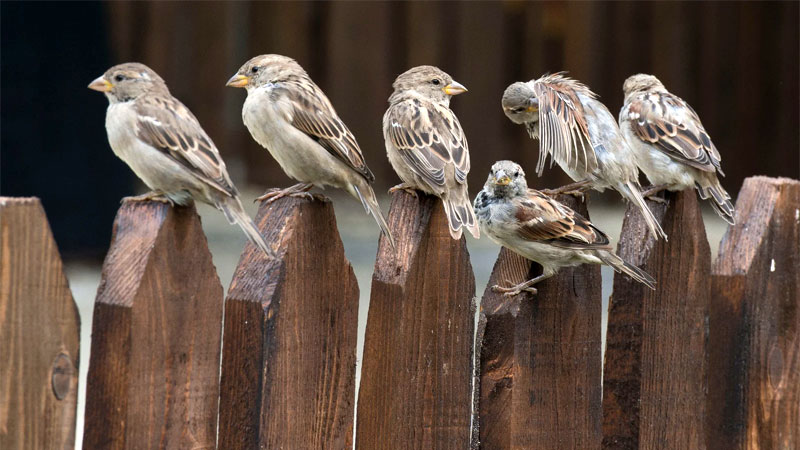
 Just tell me how to get rid of ’em.
Just tell me how to get rid of ’em.